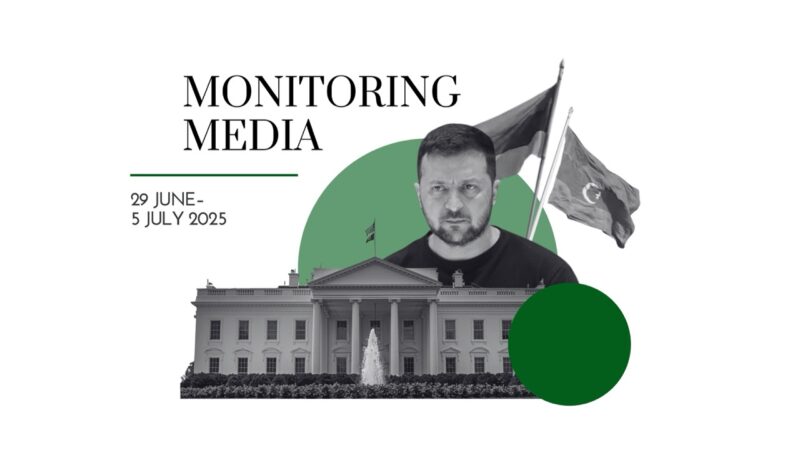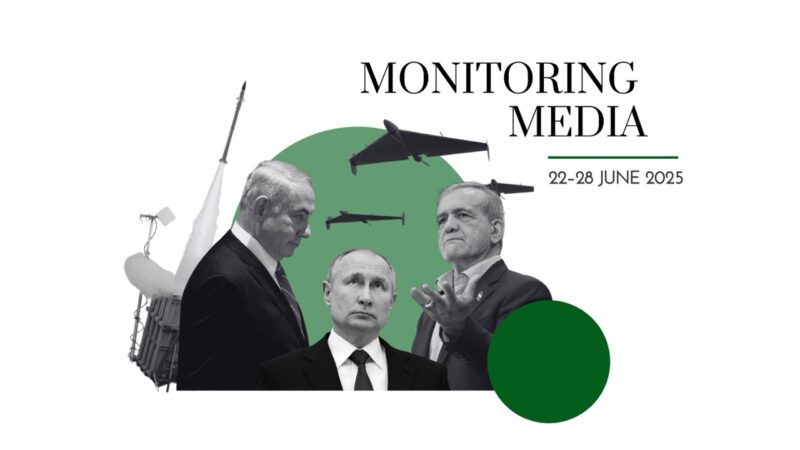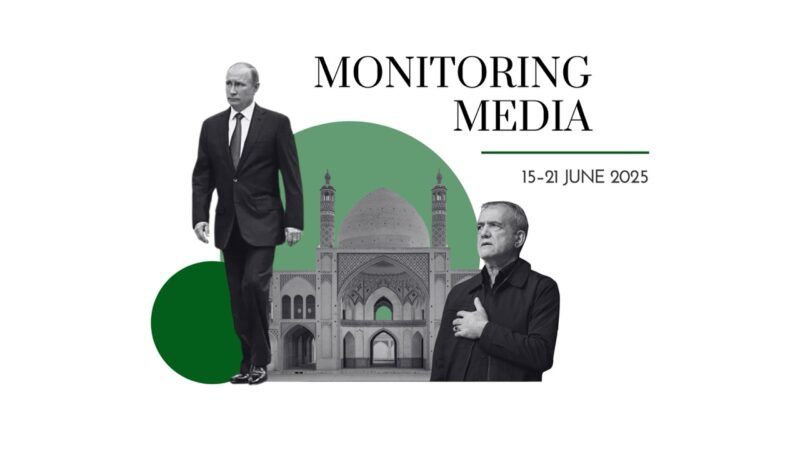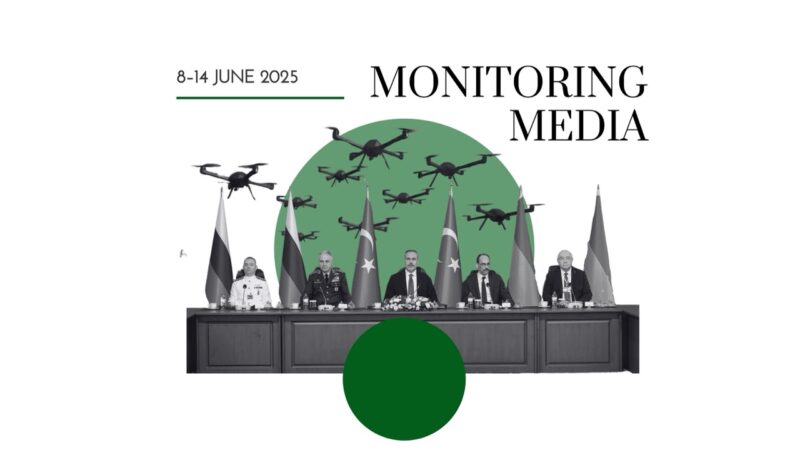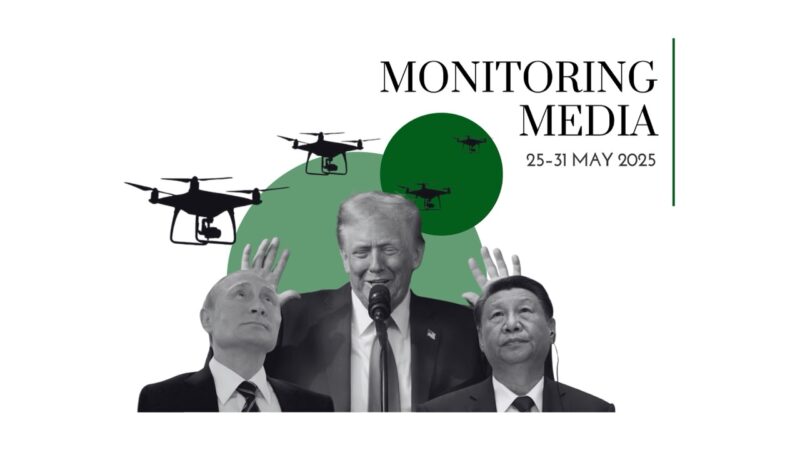Russo-Ukrainian war exemplifies international conflicts of the future

CIUS weekly report on North American media coverage of Ukrainian affairs, 4–10 February 2023
Three publications (The Economist, Foreign Affairs, and Foreign Policy) were selected to prepare this report on how the situation in Ukraine has been portrayed in the North American press during the past week (4–10 February 2023). The sample was compiled based on their impact on public opinion as well as on their professional reputation, popularity among the readership, and topical relevance. These three publications represent centrist and conservative viewpoints on the political spectrum.
This report covers only the most-read and relevant articles about Ukraine, as ranked by the respective North American publications themselves in the past week. Its scope covers promoted articles on home pages and articles from special sections on Ukraine, with the hashtag #Ukraine, from the paper editions of the publications, and about Ukraine from opinion columns and editorials.
Topics featured in the selected articles:
- Ukraine’s current affairs: Ukraine’s victory is one of the keys to Belarus’s freedom; thousands of Ukrainian soldiers are facing serious psychological issues; Ukrainian army learned to ram Russian drones with its own drones;
- The world and Ukraine: the wartime actions of Ukraine and Russia offer important lessons for the rest of the world; the Russo-Ukrainian war demonstrates the superiority of technological innovations in modern combat;
- Russia at war: Russia used delusional premises to invade Ukraine; Russia wants to conquer maximum territory in the minimum amount of time; Russia is unlikely to resort to nuclear weapons in the nearest future; Russian economy and society become further militarized.
Main arguments:
Ukraine’s victory against Russia will help dismantle the Lukashenka regime in Belarus. Eric S. Edelman, Vlad Kobets, and David J. Kramer (Foreign Policy) state that according to public sources and Ukrainian intelligence assessments, Russia is planning a new offensive in Ukraine that may unwind from the territory of Belarus. During the last year, Lukashenka’s regime supported the invasion significantly—Russians trained their soldiers, stationed aircraft, and acquired military equipment in Belarus. The authors argue that the West’s contribution to Ukraine’s victory will not only strengthen European security but “weaken Putin significantly enough that he can no longer bail out his fellow dictator [and that will] embolden Belarusians to try their hand at removing Lukashenko once more.” The article narrates the story of how Lukashenka has been usurping power since 1994, which eventually led to wide-scale protests against the falsification of presidential elections in 2020 (brutally suppressed). They also write about the growing dependence of Belarus on Russia, which made Lukashenka agree “to allow Russian forces to use Belarusian territory to stage their invasion of Ukraine, including those who were involved in the atrocities in the Ukrainian city of Bucha.” At the same time, Lukashenka remains highly reluctant to deploy the Belarus army in Ukraine, as this move may ignite a new wave of domestic protests, with no one remaining to suppress them. Therefore, Ukraine’s victory would weaken both dictators—Lukashenka and Putin—to such an extent that they would not be able to support each other. Once this occurs, “Europe and the United States should actively support Belarus’s pro-democracy movement and seize the opportunity to rid Belarus once and for all of the menace [that] has hung over it—and Europe—for nearly three decades.”
Thousands of Ukrainian soldiers suffering from post-traumatic stress disorder. The Economist writes about a military rehabilitation centre in Kharkiv oblast where around a hundred soldiers arrive per week. These soldiers have a pool of battlefield trauma syndromes: “from sleeplessness and nightmares to flashbacks and crushing feelings of guilt at having survived when so many of their comrades fell.” At this moment, around 2,000 service personnel have been provided with psychological help at that particular centre. According to The Economist, one of the major issues that Ukrainian psychologists are dealing with today is restoration of their good name in the eyes of the soldiers; in the USSR, the legacy of which remains rather strong, “psychologists were part of the political section [in the Red Army]. Their job was not to treat soldiers with problems but rather … to punish them for not being up to their job.” Today, not every soldier in need asks for help. That being said, the number of military psychologists in the Ukrainian army has increased by 40 per cent, and all servicepeople are encouraged not to be shy about turning to them. The Economist highlights that many more rehabilitation centres of such time will be needed in the future, considering the growing number of Ukrainians with battlefield experience.
Ukraine develops drone-to-drone attack tactics to destroy Russian vehicles in the air. The Economist writes that in the skies over Ukraine, a new type of dogfight is taking place today. This dogfight involves drones—unmanned aerial vehicles—and may set a few benchmarks for the future of warfare. To begin with, drones are tricky to hunt from the ground. If they are to be shot down, then the cost of the launched missile may be higher than the one of the drone. If they are to be jammed by an electromagnetic wave, then all drones in the air may become inoperative, including the friendly ones. Because both fighting sides use drones extensively for reconnaissance and the most popular models are mass-produced quadcopters, Ukrainians have developed tactics to destroy the Russian vehicles: “quadcopters have rotors on top, and their cameras point downwards. A rapid descent on a target from above makes use of this blind spot. Striking the rotor will usually cause at least one blade to break, sending the enemy spinning out of control but leaving the attacker undamaged.” That being said, Ukraine is to receive drone interceptors from Monaco soon that will be able to identify, track, and destroy enemy vehicles without human assistance. The Economist concludes that “fleets of interceptor drones may be a solution to mass drone attacks, like those on Ukraine’s power grid. Bomber drones might even gain fighter-drone escorts to protect them. In the aerial battles of the future humans could be relegated to the role of observers.”
Russo-Ukrainian war offers a handbook for modern international conflicts. In his opinion-forming piece, Stephen M. Walt (Foreign Policy) outlines five lessons that the West should have learned from the first year of the Russo-Ukrainian war. Primarily, “it is very easy for leaders to miscalculate.” Walt scrutinizes the flaws behind the decision of President Putin to invade Ukraine, which were the overestimation of Russia’s military prowess, underestimation of Ukraine’s resistance, and disbelief in Western Europe’s ability to switch to alternative energy sources. At the same time, the West discounted the possibility of a protracted war and exaggerated the peace-enforcing effect of economic sanctions. Secondly, “states unite to counter aggression.” Putin did not expect the EU and NATO members to mobilize around the idea of arming and aiding Ukraine: “states balance against aggressors because they worry that successful conquerors will try for more.” Thirdly, “it ain’t over till it’s over.” Contemporary wars against powerful states can neither be waged quickly nor are they one-sided. To knock out an organized and motivated rival with a decisive blow is almost impossible which leads to prolonged grinding and attrition on the battlefield. Fourthly, “war empowers extremists and makes compromise harder.” Walt argues that the high stakes behind every armed conflict make political hawks and hardliners proactive: “as a result, it becomes harder to discuss any sort of compromise, even when neither side has a clear path to victory.” Fifthly, “a strategy of restraint would have reduced the risk of war.” According to Walt, the Western world should have conducted more careful policies in Central and Eastern Europe. Finally, a bonus lesson: “Leaders matter.” The war develops as it does exactly because Putin, Zelensky (not Petro Poroshenko), and Joe Biden (not Donald Trump) are critical decision-makers.
Russo-Ukrainian war modifies the technical aspects of modern warfare. Sir Richard Barrons, a British general, highlights in The Economist that while the nature of war never changes (i.e., “there are no unbreakable laws or boundaries that limit what is done to survive and win”), its characteristics (i.e., “how it is actually fought”) transform constantly in response to circumstances, technology, and thinking. The Russo-Ukrainian war, one of the biggest in recent times, demonstrated that the necessity to mobilize all of the society for victory, alongside the importance to rely on the artillery on the battlefield are the two constants in the characteristics of war that have not changed since 1945. At the same time, the factor of new technology introduced major revisions. Firstly, “the use of satellite imagery to see and locate enemy positions from space has made the war in Ukraine in essence transparent … it is no longer possible to move many members of an army, navy, or air force undetected.” Secondly, uninterrupted access to the Internet, tools of artificial intelligence, and cloud computing allow to process and strike targets ten times faster than ever before. Thirdly, precision weapons demonstrate higher effectiveness if compared with deploying a massive artillery arsenal: “the American-provided HIMARS high-precision rockets deplete Russia’s ability to bring forward artillery and ammunition … precision technology offers the ability to destroy an enemy’s major weapons systems, logistics and reserves before close-quarter battle even starts.”
Russia made too many self-delusional miscalculations when invading Ukraine. Dara Massicot (Foreign Affairs) offers an extensive analytic piece which discusses the mistakes that the Kremlin made when planning and executing its invasion of Ukraine. The first such mistake was excessive secrecy—Russian troops were seemingly not aware of the major military operation hours before it commenced and could not properly prepare. Apart from this, according to Massicot:
“Russia created an invasion plan that was riddled with faulty assumptions, arbitrary political guidance, and planning errors that departed from key Russian military principles. The initial invasion called for multiple lines of attack with no follow-on force, tethering the military to operational objectives that were overly ambitious for the size of its forces. And the Kremlin erroneously believed that its war plans were sound, that Ukraine would not put up much resistance, and that the West’s support would not be strong enough to make a difference.”
Other problems with Russian performance in Ukraine include failed reforms to modernize and re-train armed forces, insufficient attempts to improve military logistics (including after the invasion of Ukraine), misunderstanding of the moods of Ukrainian society, miscommunicating the war to the Russian population (it was branded as a “special operation” and, therefore, not a very “important” business), and many more. At the same time, Massicot highlights that none should underestimate Russia’s ability to learn from mistakes, as well as its artillery firepower, high numbers of heavy equipment, radio jamming capacities, and other features.
Russia aims to conquer as much territory as possible before Western weapons arrive in Ukraine. Amy Mackinnon and Jack Detsch (Foreign Policy) write that Russia has deployed hundreds of thousands of troops in the Donbas, and Ukraine may not have a response to that because Western tanks and other equipment have yet to arrive: “Ukrainian officials estimate that Russian forces inside the country have surpassed the 300,000 mark [this numbers] are significantly higher than the invading force … used to invade the country last February—and this time, they are highly concentrated in eastern Ukraine.” The offensive tactic that the Russian command uses today is ruthless—recently mobilized and poorly trained soldiers are thrown on the battlefield and often die in human-wave attacks to uncover the positions of Ukrainian defenders. Nevertheless, unceasing and dense storming is a tactic employed by the Russians to bind Ukrainian forces and inflict damage. Apart from this, “Russia has also begun arming up and digging in for a coming offensive. The Ukrainian military estimates that Russia already has 1,800 tanks, 3,950 armoured vehicles, 2,700 artillery systems, 810 Soviet-era multiple-rocket-launch systems such as Grad and Smerch, 400 fighter jets, and 300 helicopters ready for the new wave of attacks.” Highlighting this Russian accumulation of power, Mackinnon and Detsch write that the US-made Bradleys and Abrams will likely not reach Ukraine before April; ground-launched small-diameter bombs will take even more time to arrive. Mackinnon and Detsch conclude that “the Russian military is seeking to advance as much as possible before the arrival of that new slate of Western military equipment.” The Donbas was placed at the core of
all Russian operations.
Russian security protocols make a nuclear attack on Ukraine unlikely in the nearest future. Kristin Ven Bruusgaard (Foreign Affairs) starts with the statement that since the beginning of the invasion, Western leaders have been trying to specify Russia’s security “red lines,” the violation of which would lead to the nuclear bombardment of Ukraine. According to Ven Bruusgaard, for Western leaders “to prevent the Kremlin from using its missiles … they must understand the protocols that govern Russia’s nuclear weapons.” In Russia, unlike in the US, the President is not the only person to authorize the use of nuclear weapons in combat. This system of checks and balances was designed in Soviet times to prevent “an aging Communist Party leader, for example, or one suffering from dementia [from unleashing] nuclear Armageddon on a whim.” Today that means that both political (Putin) and military (Sergei Shoigu and Valeriy Gerasimov) decision-makers execute equal control over Russia’s ultimate weaponry. Ven Bruusgaard also highlights a paradox:
“Russian doctrine calls for nuclear use in a conflict that could threaten Russia’s very existence. Russian leaders, including Putin, have specified that the invasion of Ukraine is not the kind of war in which Russia would resort to nuclear weapons. But at the same time, Russian military doctrine provides little guidance for the situation Russia currently faces in Ukraine because the same doctrine declares that Russian conventional forces should be able to win this kind of war.”
The mentioned paradox makes it unclear whether, for instance, Russia’s loss of control over Crimea will provoke nuclear retaliation. Another question is whether the Russian nuclear arsenal will perform better than the rather unsuccessful conventional forces. There are different types and kinds of missiles in Russia that require specific maintenance, which may not be rigorously performed today. Ven Bruusgaard concludes that nuclear retaliation is likely under two scenarios: if Ukraine humiliates the Russian army or if an understanding arises in the Kremlin that it entered a direct confrontation with NATO. “It is this second contingency that Western policymakers should actively seek to mitigate, by using calibrated deterring communication and military maneuvers that cannot be misinterpreted as preparations for an operation against Russia.”
Russian economy is redesigned to support the military machine. The Economist writes that Russia’s economic system, though being under stress from funding the invasion, gets adapted and redesigned to sustain the war effort: “tough European and American sanctions, introduced in the wake of the invasion of Ukraine last February, were supposed to isolate the Russian economy [but] traders in friendly countries like Turkey, Kazakhstan, India, and China now facilitate the import of the restricted goods Russia needs, for a price.” Apart from that, unemployment remains rather low in Russia, the prices for real estate stabilized, not all big Western businesses left the domestic market, and the IMF even expects the state to grow by 0.3% in 2023. These and other successes were achieved not least due to Putin’s decision to task educated technocrats—the “elite prisoners”—with stabilizing the economy. Moreover, The Economist highlights that the Kremlin is intended to militarize the state further. In December 2022, Putin declared that there would be “no limits” to the resources available for the armed forces. That declaration means, on the one hand, the “cannibalization” of the national economy “into a more primitive wartime outfit,” and, on the other hand, significant cuts in other branches, such as health and education. The Economist concludes that the militarization of the economy goes hand in hand with the militarization of society, which has already started and will have a long-term impact on people’s consciousness.
